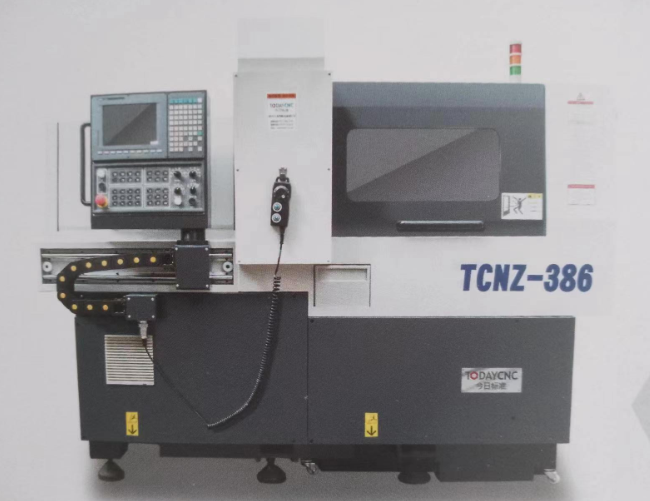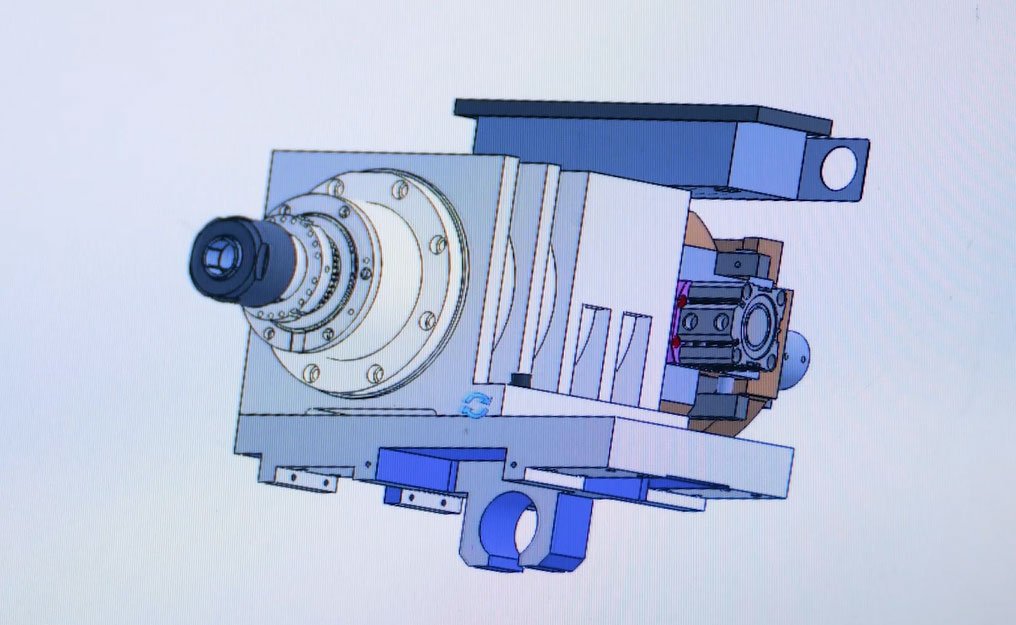1 Machine tool feed system model and its accuracy
The feed system of CNC machine tools is mainly the servo feed method of servo motor + ball screw. The rotary motion output by the servo motor is converted into linear motion of the controlled object through a series of intermediate transmission devices such as couplings and ball screw pairs. The structural block diagram of its mechanical system is shown in Figure 1, and the mathematical model is:
In the formula: θi (s) is the input quantity (motor angle); Xo (s) is the output quantity (workbench displacement); J is the equivalent moment of inertia; C is the equivalent viscous damping coefficient; K is the equivalent stiffness.
It can be seen that this is a second-order system, consisting of a proportional link and an oscillating link.
For the performance analysis of the CNC servo drive feed system, its dynamic characteristics and servo accuracy are mainly considered.
The accuracy of CNC servo is measured by the size of servo error. The so-called servo error is the difference between the command position and the actual position of the servo system in the steady state, which is usually called the steady-state error. It reflects the steady-state quality of the system.
In the analysis of the CNC feed system, the entire system is often simplified into a block diagram as shown in Figure 2. In the figure, T0 is the time constant of the electromechanical system, K0 is the comprehensive servo adjustment unit, and 1/S is the transfer function of the mechanical feed transmission structure.
As can be seen from Figure 2, the simplified CNC system is an I-type system, so when the system uses step input, the steady-state error is 0; when using a ramp signal input, the steady-state error is (where υ is the feed speed).
A general CNC machine tool table has two axes of movement, and the two axes are driven separately. The block diagram is shown in Figure 3. In the following analysis, the nonlinear link is simplified and the mechanical part is simplified into a proportional link.

Contour accuracy can be defined as the distance value between the desired path and the actual path. Assuming that P* is the position vector on the desired straight line or curve contour; P is the corresponding actual position vector; and P1* is the position vector closest to P on the desired contour, then the contour error vector Er is defined as
When the motion axis has tracking speed, through further calculation, the I-type servo system has a position vector error E, and the contour error can be obtained as
The equation indicates that the contour error is determined by the position error [Ex Ey]T and tracking speed [υx υy]T of the servo system. For the I-type servo system, under the reference speed input condition, the position error must exist, let Kυx and Kυy represent respectively The speed error coefficient of the x- and y-axis servo systems, then the steady-state error can be obtained as
2 Precision control of feed system
A five-axis CNC system test platform based on PMAC motion controller is designed. Three movements (x, y, z) are directly driven by stepper motors and fed back by grating rulers and encoders. Two rotations are driven by stepper motors. The incoming motor is driven by a worm gear pair for reduction and feedback from the encoder. The motion controller uses PMAC-PCI04 eight-axis card, the host computer uses an industrial personal computer (IPC), and uses RS232 serial port communication.
2.1 Adjust the accuracy of the system through the step response process
In a linear steady control system, the step input signal is the worst excitation signal. If the system still meets the requirements under the step excitation, then it will meet the requirements under other external excitations. Therefore, if the step function is used as the input of the system and the response of the system is measured, information about the dynamic characteristics of the system can be obtained.
Select the y-axis motor on the PID adjustment interface of PMAC, set the amplitude and time of the step signal, and select the pulse signal. Adjust step by step according to the general principles and steps of PID adjustment.
Figure 4(a) shows the response of the system during automatic adjustment. The system has a large following error and the curve is accompanied by oscillation. Therefore, it is difficult for automatic adjustment to meet the control requirements and manual adjustment is required. The curve in Figure 4(b) is obtained after manual adjustment of the PID parameters of PMAC. It is ideal and can meet the control requirements.

2.2 Adjust the accuracy of the system through the parabolic response process
For a position servo system without feedforward, the following error is always proportional to speed and acceleration. After the servo system introduces the velocity feedforward and acceleration feedforward terms, the system following error can be reduced or eliminated by adjusting the velocity feedforward and acceleration feedforward with parabolic response. The dynamic characteristics of the system are studied and evaluated through the parabolic response of the system, and the dynamic performance of the system is judged through the speed following error during the parabolic response of the system.
The adjustment method is to first adjust the feedforward term and run a series of parabolic movements to observe the effect, with the purpose of reducing the following error and correlation coefficient. Starting from 0, increase the feedforward gain (velocity feedforward, and set acceleration feedforward to 0, lx35=0) until the ratio is as close to 0 as possible.
Figure 5 shows the parabolic response of the motor under different speed feedforward coefficients kvff. The response curve (kvff=0) shown in Figure 5(a) indicates that the speed following error of the system is too large during the parabolic response process. The main reason is the influence of damping, which should be adjusted by increasing the speed feedforward coefficient k; Figure 5(b) The response curve (Kvff=10000) shown in ) indicates that the speed following error of the system is in reverse phase during the parabolic response process. The main reason is that if the speed feedforward coefficient is too large, K should be reduced. Adjust it; the response curve (Kvff=3620) in Figure 5(c) shows that the speed following error of the system is minimized during the parabolic response process, and it is concentrated in the middle and evenly distributed along the motion trajectory, which is an ideal adjustment result.
2.3 Improving the positioning accuracy of the system through pitch error compensation
The performance and accuracy of the CNC feed system can be improved through certain controllable algorithms, such as using PID + feedforward control. However, the accumulated errors of the mechanical transmission system, thermal degeneration errors, errors caused by wear, etc. cannot be eliminated or reduced by the control algorithm. , and these errors have a great impact on the position accuracy of the system, especially the positioning accuracy, and ultimately affect the dimensional accuracy or contour accuracy of the processed workpiece. Therefore, the positioning accuracy of the system must be improved through compensation methods, and the pitch error compensation function provided by PMAC is used to realize online compensation of the pitch error and improve the positioning accuracy of the system.
The principle of pitch error compensation is to artificially create an error that is equal in size and opposite to the original error to compensate and correct the original error. Right now
In the formula: εi is the positioning error value of each positioning point; εi'''' is the error correction value.
The process for establishing compensation is as follows:
(1) Based on the measured cumulative pitch error, calculate the amount that should be compensated and convert it into the format of a pitch compensation table (Table 1). The compensation amount unit in the compensation table is 1/16 pulse, which represents the gap shrinkage rate and is used to determine How quickly the gap shrinks when changing direction.
(2)

(2) Define the pitch compensation table and related parameters in the execution program.
According to the pitch error compensation table, write the following compensation program (forward):
#2; Specify the motor to be compensated as motor No. 2
DEFINE COMP 17, 1604000; the number of points to be compensated is 17 (forward), covering 1 604 000 pulses, the point spacing is 10 000cts, that is, the encoder pulse
1288-288+144+464+880
+880+1104+1264+560+240
+144+32—80—176—176—400 0
1286=288; Zero gap compensation
151=1; make compensation effective HL)
(3) Download the compensation program program to the PMAC card and run it.
At this point, the compensation for the cumulative pitch error has been established, and the system will automatically load this compensation program when executing motion control instructions. After error compensation and experiments, the positioning accuracy of the feed system increased by 2 μm, and the repeat positioning accuracy increased by 7 μm.
3 Conclusion
The accuracy of the CNC feed system is determined by many aspects. Only through various measures can its comprehensive accuracy be effectively controlled. Among them, reasonable PID parameters can improve the steady-state performance and dynamic quality of the CNC feed system, and acceleration/speed feedforward can Improve the motion accuracy of the CNC feed system, and the pitch error compensation method can effectively improve the positioning accuracy of the system. Through testing on the PMAC-controlled five-axis CNC test bench, high feed accuracy was obtained.








